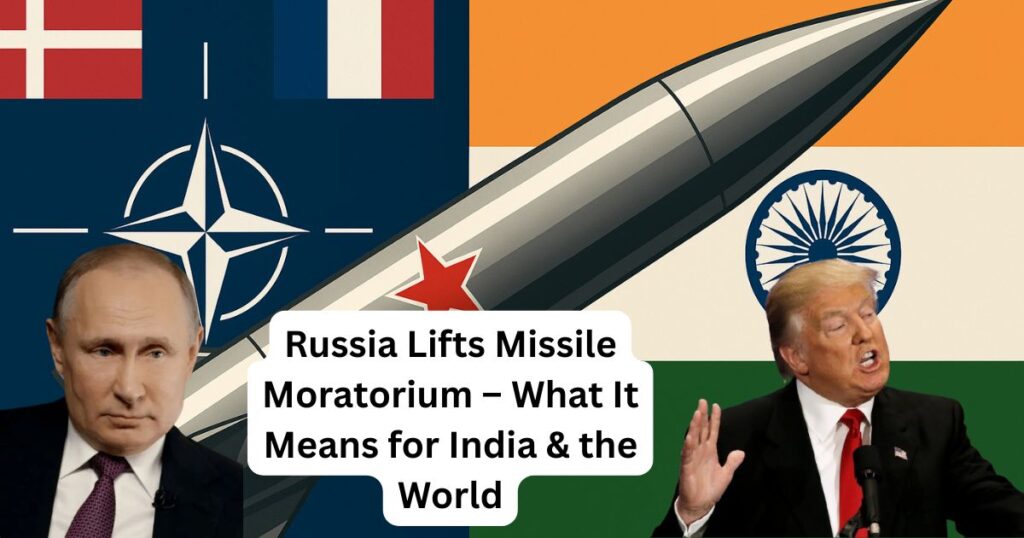On August 5, 2025, Russia declared that it would no longer follow its self-imposed Missile Moratorium on deploying short- and medium-range ground-launched missiles (ranging from 500 to 5,500 km). In simple terms, Russia had promised not to station (or prepare for use) such missiles, but now it’s backing out of that promise. The Russian Foreign Ministry stated that US actions, like deploying missiles in Europe and the Philippines, forced Russia to take this step.

This news is significant because it could change global security. Tensions between Russia and the US are already high, and this decision might make things worse. Recently, US President Donald Trump, re-elected in 2024, announced on August 1, 2025, that he was sending two nuclear submarines near Russia. Russia saw this as a threat and responded by lifting its moratorium. This is tied to the 1987 INF Treaty, which the US abandoned in 2019. This could spark a new arms race, affecting countries like India.
What Was the 1987 INF Treaty?
In 1987, the US and the Soviet Union (now Russia) signed the Intermediate-Range Nuclear Forces (INF) Treaty. This agreement banned both countries from making, keeping, or using ground-launched missiles with a range of 500 to 5,500 km. These missiles were dangerous because they could hit enemy cities in just a few minutes, increasing the risk of war.
For example, if Russia placed such a missile in Europe, it could target London in under 10 minutes. Under the INF Treaty, both sides destroyed thousands of missiles, like the US Pershing II and Soviet SS-20. This deal helped end the Cold War, a time when the US and Russia were rivals. Both countries also inspected each other’s weapons to ensure no cheating. But in 2019, the treaty collapsed, changing the global landscape.
Why Did the US Abandon the INF Treaty in 2019?
On August 2, 2019, the US announced it was pulling out of the INF Treaty. The main reason was that it accused Russia of developing a new missile, called 9M729 (NATO name: SSC-8), which could travel over 500 km, breaking the treaty rules. Russia denied these claims. Another reason was China, which wasn’t part of the treaty and was building similar missiles. The US felt it was falling behind both Russia and China.
When the US left, Russia also said it wouldn’t follow the treaty. Both started developing new missiles. This increased tensions in Europe, where fears of new missile deployments grew. The US placed its Typhon missile system in the Philippines, raising concerns in Asia. This move fueled a global arms race, forcing other countries to rethink their security strategies.
Why Did Russia Lift Its Missile Moratorium?
On August 5, 2025, Russia said it would no longer follow its missile moratorium. It argued that the US had already broken the INF Treaty and was now placing Typhon missiles in Europe (like Germany) and Asia (like the Philippines). Russian Foreign Ministry spokesperson Maria Zakharova said, “The US destroyed the treaty, so we are no longer bound by it.” Former Russian President Dmitry Medvedev warned, “NATO’s growing actions must face consequences.”
Russia also pointed to Trump’s August 1, 2025, announcement about sending nuclear submarines near Russia as a provocation. Russia feels that the US and NATO are surrounding it, so it needs to prepare its missiles for defense. This marks a major shift in Russia’s defense policy.
Trump’s Submarine Move: What’s the Connection?
On August 1, 2025, Trump posted on Truth Social that he was sending two nuclear submarines near Russia. He called it a “strong response” to Russia’s warnings. Medvedev had earlier said NATO should expect Russia’s reaction. Trump described this as a “madman strategy,” meaning a bold move to scare the opponent.
Russia saw this as a direct challenge. Four days later, on August 5, it lifted its missile moratorium, linking it to the US’s submarine move and missile deployments. Russia said these actions were tied to the collapse of the INF Treaty, creating a Cold War-like situation.
What Missiles Does Russia Have?
Russia has several missiles that can travel 500 to 5,500 km. They fall into two types:
- Ballistic Missiles: Like the Iskander-M, which can hit up to 500 km, but Russia is upgrading it. The new Oreshnik missile, tested in Ukraine in 2024, can reach 2,500-3,000 km. It’s super fast (Mach 10) and can dodge radars.
- Cruise Missiles: Like the Kalibr, which, when launched from the ground, can hit 1,500-2,500 km with precision.
Russia could deploy these in Belarus or Kaliningrad (near Europe). These missiles are so fast that enemies get little time to respond, making them dangerous.
How Will Europe and Asia Be Affected?
Europe: If Russia places missiles in Belarus or Kaliningrad, countries like Germany and Poland will face greater threats. NATO might respond by boosting missile defense or deploying US Typhon missiles.
Asia: The US has placed Typhon missiles in the Philippines, angering Russia and China. Russia could team up with China to counter Japan or Australia.
This will disrupt global security. NATO will need to spend more, and countries like India may face challenges in buying Russian weapons.
Risks: Fear of War Due to Misunderstandings
These missiles increase the risk of war. They’re so fast that enemies get only 5-15 minutes to react. If a radar picks up a false signal, a country might think it’s under attack and launch nuclear missiles. Oreshnik-like missiles can evade radars, raising the stakes. During the Cold War in 1983, a similar misunderstanding nearly led to war.
Diplomatic Options: What’s Left?
To reduce tensions, some options remain:
- Talks: The US and Russia could extend agreements like New START to limit missiles.
- Transparency: Both could share missile data.
- Hotlines: Strengthen direct leader communication.
- Include China: Since China builds similar missiles, it should join talks. Despite mistrust, dialogue can prevent war.
Impact on India and Other Countries
India faces challenges. Russia is a key partner, supplying 40% of India’s oil (2024) and weapons like S-400. But if US-Russia tensions rise:
- The US may pressure India to stop buying from Russia.
- Russia’s new missiles could be offered to India, but this might upset the US.
- Tensions in the Indo-Pacific could affect India’s QUAD alliance. Countries like Pakistan or China might take advantage.
Is This a New Cold War?
Some experts say yes, this is a new Cold War. Russia and the US are stockpiling weapons, like in the 1980s. The Ukraine war is an example. Others argue it’s not, as global trade and energy ties prevent war. Still, tensions are high, and without talks, things could worsen.
Timeline: Key Events
- December 8, 1987: US and Soviet Union signed the INF Treaty.
- 2013-2018: US accused Russia of breaking the treaty (9M729 missile).
- February 2, 2019: US announced INF withdrawal.
- August 2, 2019: INF Treaty ended.
- November 2024: Russia tested Oreshnik missile.
- August 1, 2025: Trump announced nuclear submarine deployment.
- August 5, 2025: Russia lifted missile moratorium.
Statements and Sources
- Russian Foreign Ministry (August 5, 2025): “The US broke the treaty, so we’re no longer bound.” (tass.com)
- Medvedev: “NATO should expect our response.” (aljazeera.com)
- Trump (August 1, 2025): “Two nuclear submarines are being sent.” (truthsocial.com)
ALSO READ- India-US trade and Trump’s new tariff on India: 25%+25%
Conclusion: What to Watch Next
This decision could make the world more tense. Russia may deploy new missiles, prompting NATO and US responses. In the next 1-3 months, watch:
- Where Russia places missiles.
- NATO’s reaction.
- Whether US-Russia talks happen. UN discussions may also arise.
What was the INF Treaty?
1987 agreement banning 500-5,500 km missiles, ended in 2019.
Can Russia’s missiles reach India?
Oreshnik can hit 3,000 km. If deployed in eastern Russia, it could reach India.
Will this increase war risks?
Yes, short response times raise misunderstanding and nuclear war risks.
Why did Russia lift the Missile Moratorium?
Due to US Typhon deployments and Trump’s submarine announcement. Then Russia lifts the Missile Moratorium?


